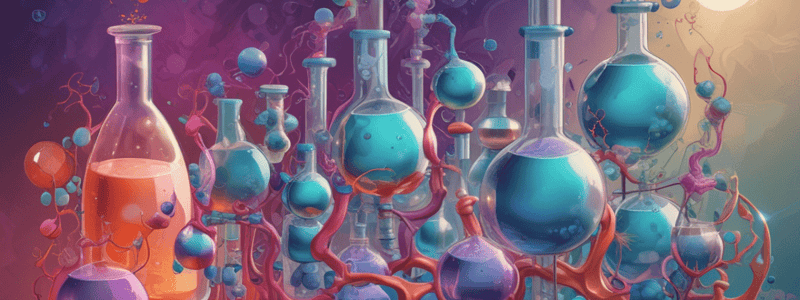Podcast
Questions and Answers
Polymers are substances of high molecular weight made up of repeating ______ units.
Polymers are substances of high molecular weight made up of repeating ______ units.
monomer
The physical and mechanical properties of the polymer can be tailor-made by changing the ______ of the polymer.
The physical and mechanical properties of the polymer can be tailor-made by changing the ______ of the polymer.
composition
Polymers formed from more than one monomer type are called ______.
Polymers formed from more than one monomer type are called ______.
copolymers
Polymers can be Linear or ______ in structure.
Polymers can be Linear or ______ in structure.
______ chains have a higher chance of approaching each other in their solid state, which increases their crystallinity and melting temperature.
______ chains have a higher chance of approaching each other in their solid state, which increases their crystallinity and melting temperature.
Very highly cross-linked polymers are very rigid (three dimensional) structures that degrade at high temperatures before their chains start to ______.
Very highly cross-linked polymers are very rigid (three dimensional) structures that degrade at high temperatures before their chains start to ______.
If a polymer is cross-linked, its ______ will be sacrificed at the expense of swellability.
If a polymer is cross-linked, its ______ will be sacrificed at the expense of swellability.
Gels are formed when crosslinked polymers are added to ______ (most commonly water).
Gels are formed when crosslinked polymers are added to ______ (most commonly water).
Polymers used for preparation of gels are called ______ agents (eg: carbapol)
Polymers used for preparation of gels are called ______ agents (eg: carbapol)
Polymers are rarely 100% ______ as it is difficult for all regions of all chains to become aligned
Polymers are rarely 100% ______ as it is difficult for all regions of all chains to become aligned
Polymers can be used as ______ coatings to mask the unpleasant taste of a drugs
Polymers can be used as ______ coatings to mask the unpleasant taste of a drugs
To modify drug release characteristics [controlled release (e.g.extended, pulsatile and targeted) enhanced stability and improved ______
To modify drug release characteristics [controlled release (e.g.extended, pulsatile and targeted) enhanced stability and improved ______
Inert and compatible with ______ environment
Inert and compatible with ______ environment
An example for ______ based technologies in drug delivery
An example for ______ based technologies in drug delivery
Flashcards are hidden until you start studying
Study Notes
Introduction to Polymers
- Polymers are substances of high molecular weight made up of repeating monomer units.
- Examples of polymers include proteins (monomer is amino acid) and polysaccharides (monomer is saccharide).
- The word "polymer" means "many parts".
- The physical and mechanical properties of polymers can be tailored-made.
Polymer Categories
- Polymers can be categorized based on composition into homopolymers and copolymers.
- Homopolymers are formed from identical monomeric units, while copolymers are formed from more than one monomer type.
- Polymers can also be categorized based on linkage and structure into linear, branched, cross-linked, crystalline, amorphous, and entangled polymers.
Branched or Linear Polymers
- Polymers can be branched or linear, and branched polymers can form networks of polymers.
- Branched chains can freely move, which offers the polymer a low melting temperature.
- Linear chains have a higher chance of approaching each other in their solid state, which increases their crystallinity and melting temperature.
Polymer Crosslinking
- Linear or branched chains may be joined by crosslinks, which restricts their movement.
- Very highly cross-linked polymers are very rigid (three-dimensional) structures that degrade at high temperatures before their chains start to move.
- If a polymer is cross-linked, its solubility will be sacrificed at the expense of swellability.
Gels
- Gels are formed when crosslinked polymers are added to solvents (most commonly water).
- The polymers do not dissolve in the solvent but instead swell.
- Incorporation of the solvent into the structure of the polymers leads to the formation of the gel.
- Polymers used for preparation of gels are called gelling agents (e.g., carbapol).
Crystalline and Amorphous Polymers
- Polymers are rarely 100% crystalline as it is difficult for all regions of all chains to become aligned.
- Polymers can have both crystalline and amorphous regions.
Pharmaceutical Applications of Polymers
- The pharmaceutical applications of polymers range from their use as binders in tablets to viscosity and flow controlling agents in liquids, suspensions, and emulsions.
- Polymers can be used as film coatings to mask the unpleasant taste of a drug.
- Polymers can enhance drug stability, modify drug release characteristics, and improve bioavailability.
Characteristics of Ideal Polymer System
- Inert and compatible with the environment.
- Nontoxic.
- Easily administrable.
- Easy and inexpensive to fabricate the dosage form.
- Good mechanical strength.
- Example: polymer-based technologies in drug delivery.
Studying That Suits You
Use AI to generate personalized quizzes and flashcards to suit your learning preferences.




